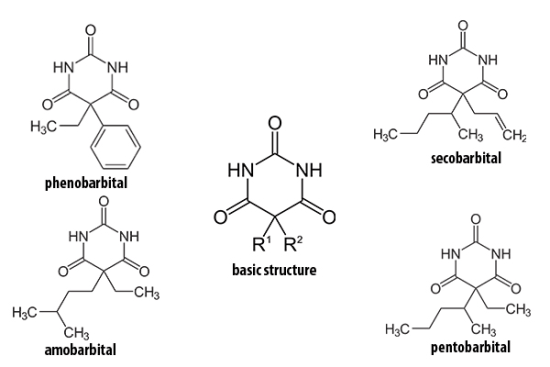Have you ever considered that Veritaserum, the powerful truth serum from Harry Potter, might exist? Chemists and pharmacologists actually had Professor Snape’s potion ingenuity and synthesized amobarbital: a widely used truth serum in psychological therapy. However, amobarbital is merely a member of the barbiturates, a group of drugs famous for their depressing effects on the central nervous system.
To figure out barbiturates’ effects, we must first talk about how neurons interact with each other. Neurons release chemicals (neurotransmitters) to nearby brain cells when stimulated. Neurotransmitters in turn bind to specific proteins on other neurons and either enhance or reduce neural activities. Nevertheless, these protein receptors can also interact with other chemicals. According to Richard W. Olsen from UC Riverside, barbiturates kick in by binding to neurotransmitters-receptor proteins.
Source: Science Photo Library – PASIEKA
In mammalian brains, GABA is the major neurotransmitter that reduces neural activities. Barbiturates bind to GABA receptors to help inhibit the central nervous system. People utilize this effect in many ways. In the case of the “Veritaserum”, J. T. Stocks reported that amobarbital, the truth serum, could induce “drowsiness, feelings of inebriation, relaxation, a sense of well-being, and a willingness to discuss things one usually would not discuss with strangers” with proper dosage. Moreover, according to McKenzie AG , the military even used amobarbital to treat “shell shock” (later known as PTSD) in enlisted men during WWII. Another kind of barbiturate, phenobarbital, is a drug used to treat certain types of epilepsy in developing countries recommended by WHO.
However, barbiturates also have other common use. Los Angeles Times reported that California proposed new drugs for lethal injections–amobarbital, pentobarbital, secobarbital and thiopeental–all of which fall in the barbiturate group. But why would people use execution drugs to treat shell shock and epilepsy? In fact, the use of barbiturates is quite controversial. Stock mentioned that amobarbital might create “false memories”. In 1994, two therapists and a medical center were sued because their use of amobarbital induced false memories, making a patient believe that she was abused by her father.

Barbiturate family. Note their common features and differences. Image Source: Warrick Ma
These aforementioned barbiturates are just the tip of the iceberg. Barbiturates are incredibly diverse because one can change the function simply by adding different molecules to them. However, their structural similarities mean they all function as central nervous system depressants. Barbiturates are hardly complex molecules in nature. It is amazing how such small molecules can greatly interfere with human physiology. Maybe the next revolutionary anesthesia or pain reliever lies in the realm of barbiturates.
Feature Image Source: syringe by WerbeFabrik










